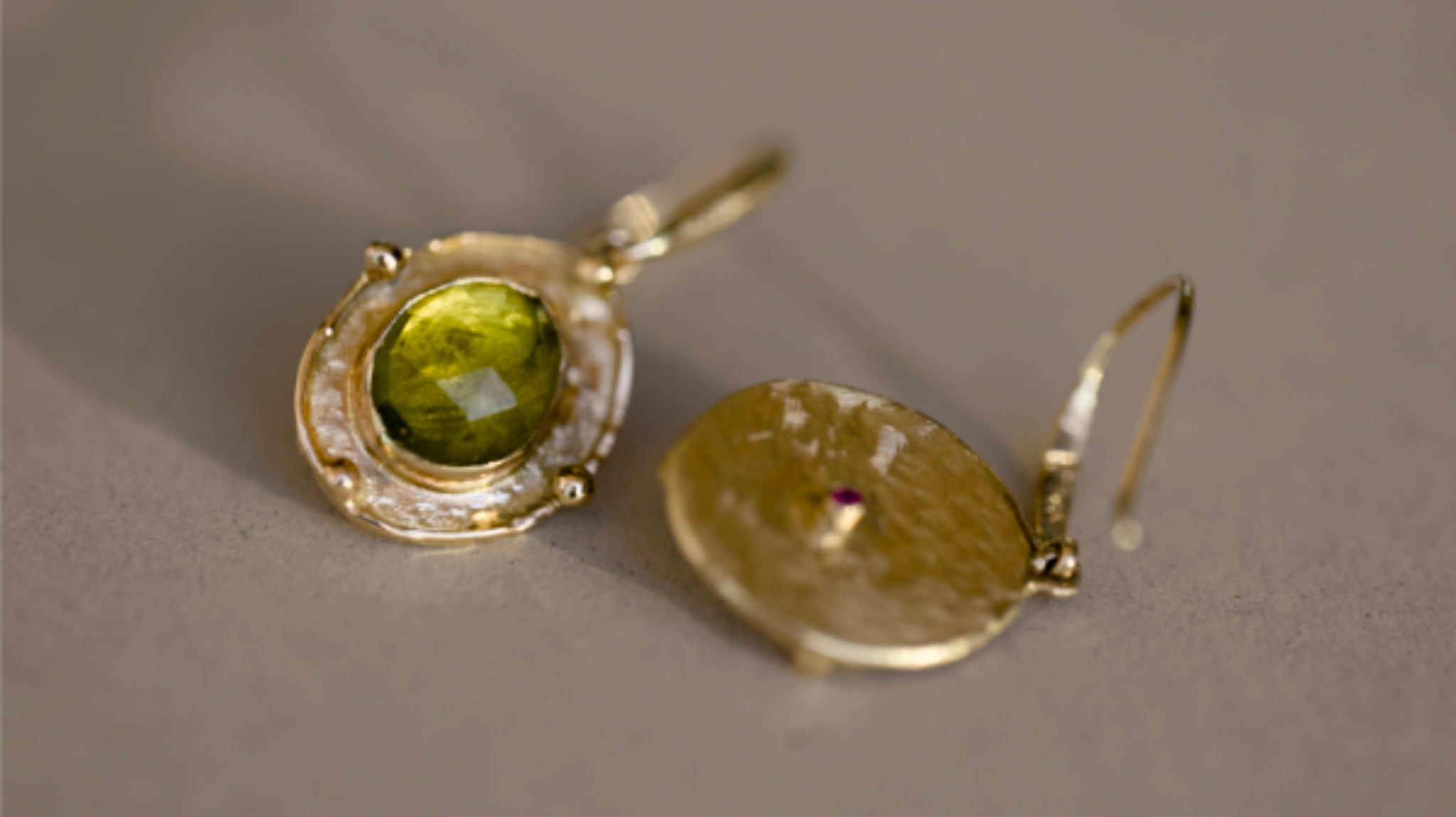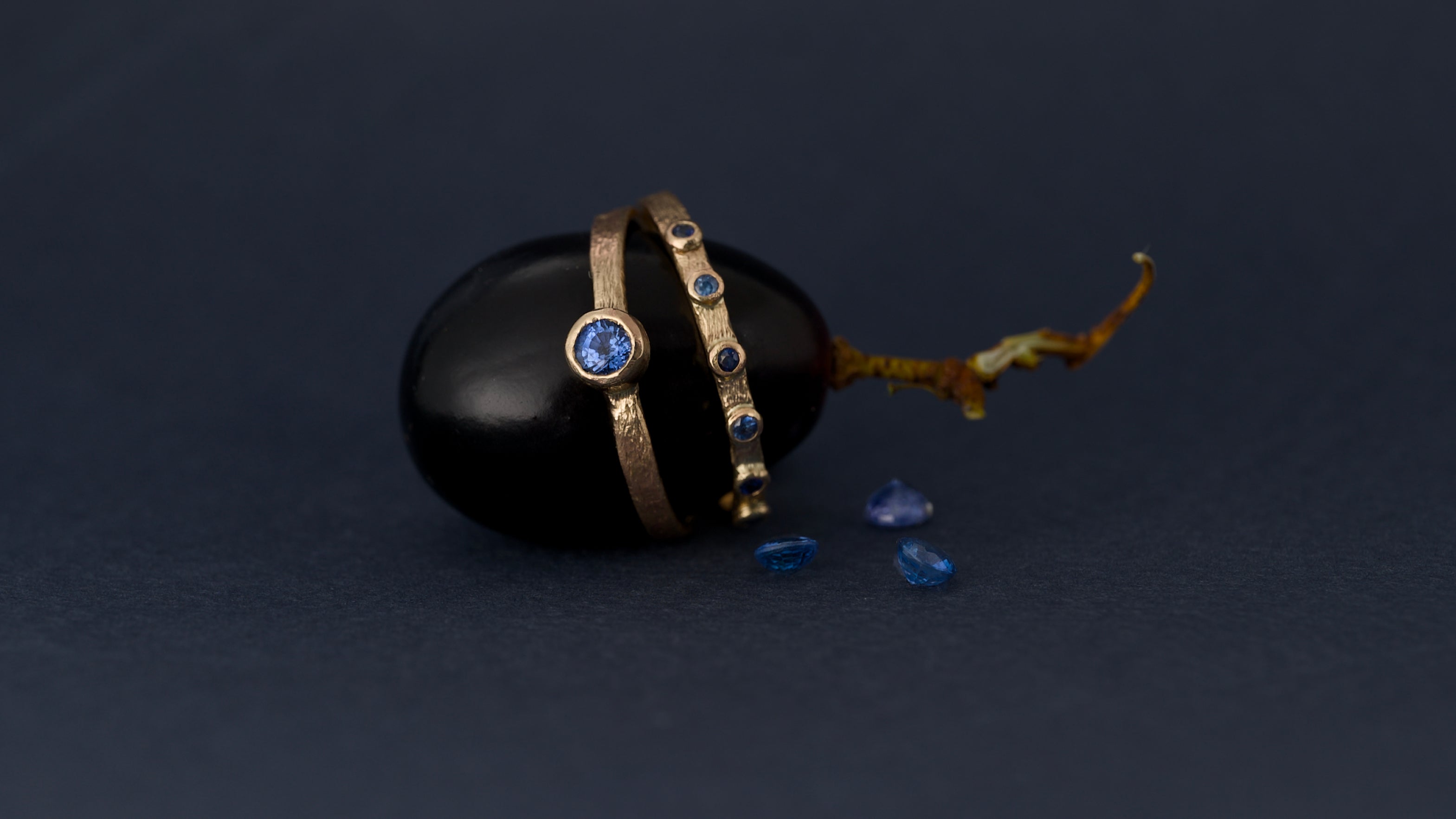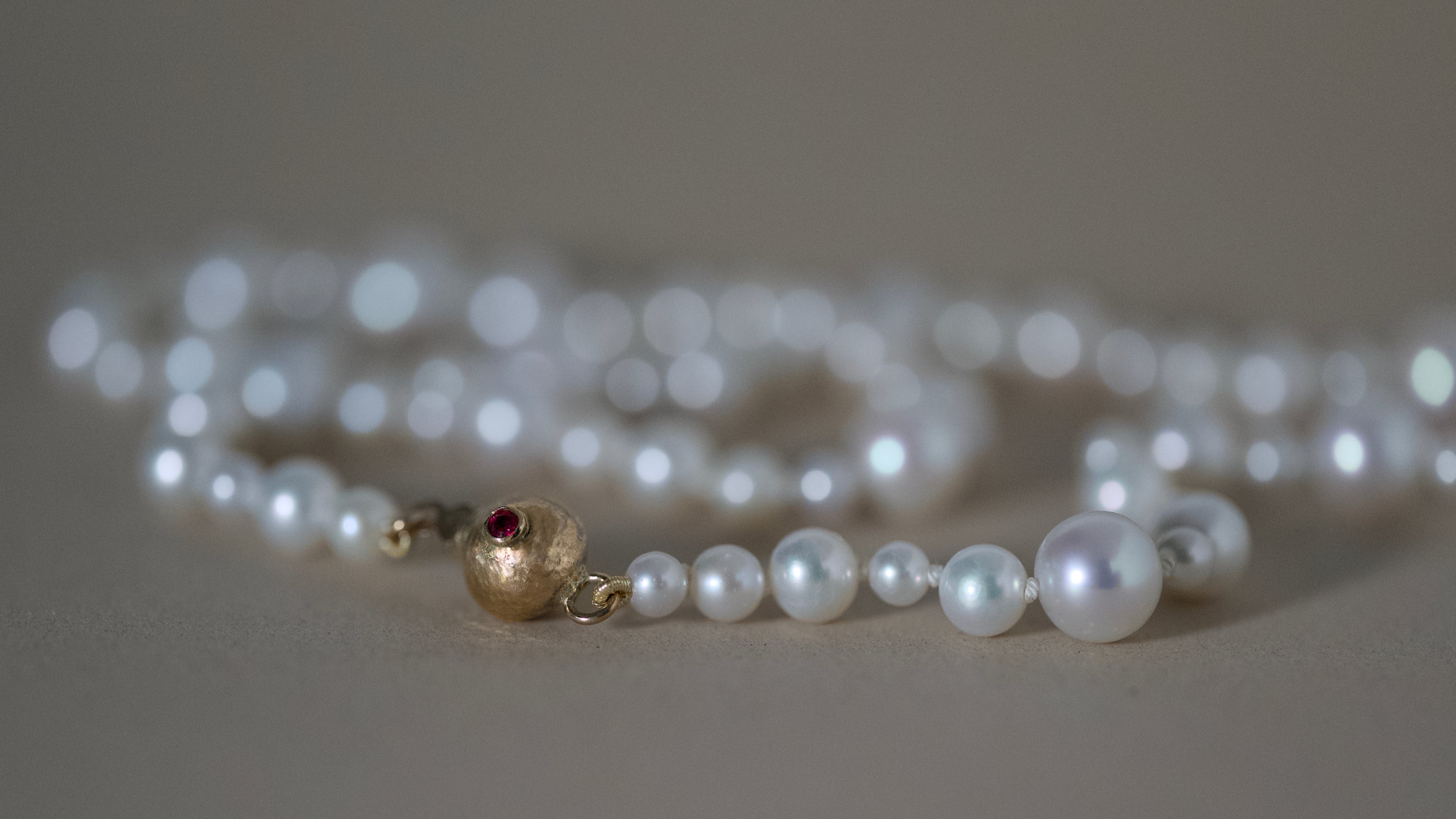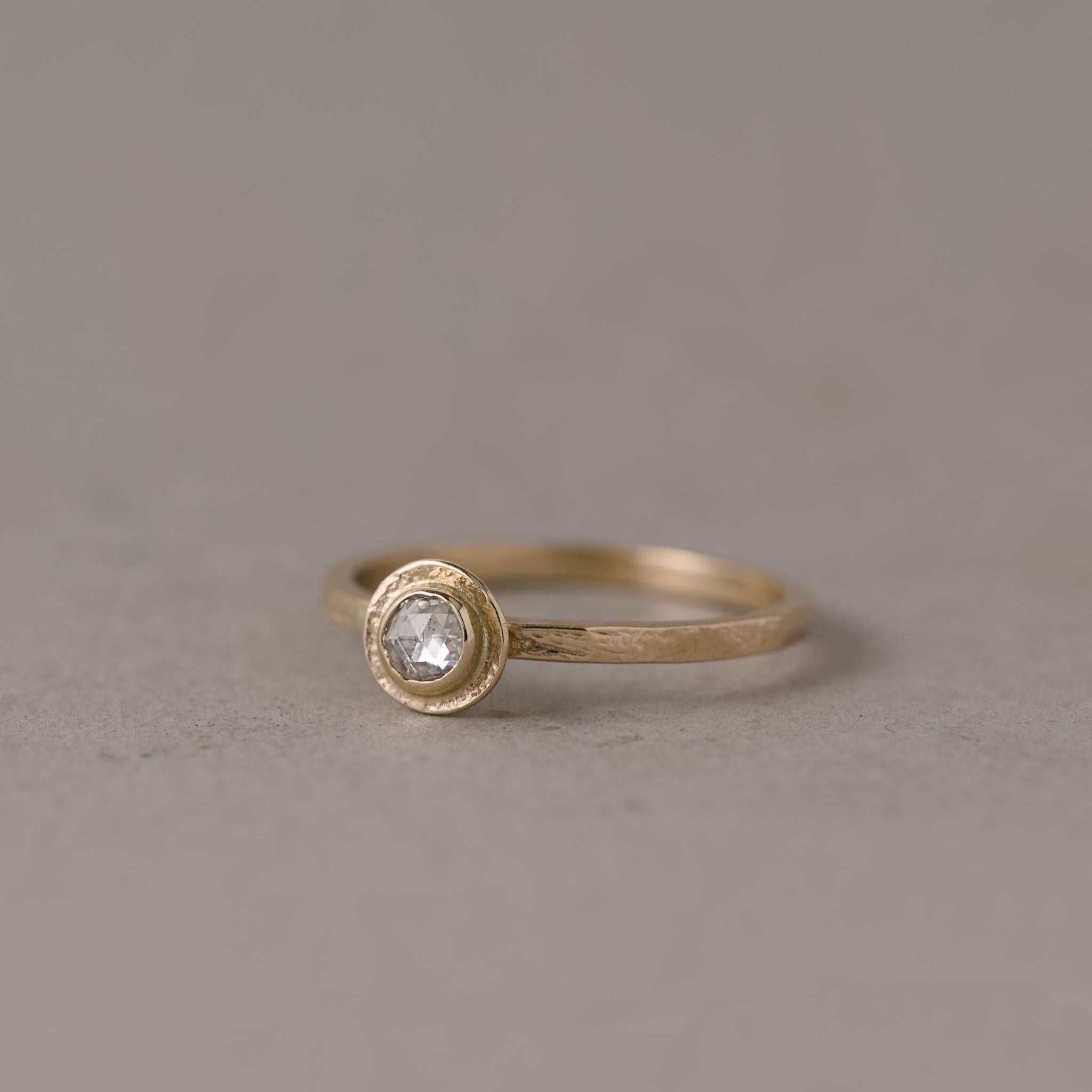There was a time — not so long ago — when to speak of Chinese pearls was to speak of the disposable. Piles of low-grade, chalky beads flooded the market, sold by weight, strung without intention. Beauty was mass-produced, and meaning was missing.
These were the old generation of freshwater pearls — tissue-nucleated, formed when a small piece of donor mantle tissue was placed inside the mussel. Without a bead nucleus to guide their growth, they formed around an irregular centre, often small, off-round, and softly lustred. To make them more appealing, many were dyed in lurid, unnatural colours — bright teals, bubblegum pinks, metallic purples — disguising their modest origins beneath a thin layer of artifice. They were produced in vast quantities, making them the most common — and cheapest — pearls on the market. Thankfully, that era has largely passed.
Today, premium freshwater pearls have arrived — a new generation of bead-nucleated pearls offering the size, roundness, and luminous lustre once found only in saltwater varieties such as Akoya, South Sea, and Tahitian. I choose to work with these pearls as a more consistent and high-quality alternative, one that allows me to create pieces that are both luxurious and enduring.
Natural vs Cultured
Any pearl grown with human assistance is considered cultured which is the majority of pearls today. Cultured pearls may be bead-nucleated, tissue-nucleated, or non-bead cultured, and are produced in both saltwater and freshwater molluscs.
Natural pearls, by contrast, are extremely rare — historically found in royal and aristocratic jewellery. Formed entirely by chance they are too scarce and limited to be within reach of all but the wealthiest collectors.
From Necessity to Innovation
For decades, production of seawater pearls was limited. Akoya, South Sea, and Tahitian pearls were cultivated in restricted regions, with long growth periods and quotas that kept global supply tight — and prices high. These limits created a challenge for the jewellery industry: how to offer pearls with the same beauty and presence to a wider audience.
Chinese pearl farmers saw the opportunity and began developing a freshwater equivalent. Adapting the bead-nucleation techniques perfected in Japan’s saltwater farms, they placed a perfectly shaped mother-of-pearl bead deep within the mussel’s inner tissue. Over 2-5years of careful cultivation, thick nacre formed around the bead, creating pearls that are large, symmetrical, and rich in colour — a genuine alternative to saltwater pearls, yet at a price more people can afford.
While bead nucleation has been a feature of saltwater pearling for over a century, it has only been documented in Chinese freshwater cultivation since 2010. For much of that time, production was limited and experimental. It is only in the last few years that these pearls have debuted in quantity at the Hong Kong Jewellery Show, captivating buyers and redefining what freshwater pearls can be. This is still a young but thrilling genre in the pearl world, evolving rapidly and gaining recognition among fine jewellers worldwide.
On occasion, I also choose premium tissue-nucleated pearls — exceptional examples that combine natural colours, near-round symmetry, and a lustre that rivals bead-nucleated gems. These are rare, and when I use them, it is because they meet my high standards for beauty and quality.
The coloured pearls I select are never dyed. Their hues — whether soft lavender, creamy peach, silvery pink, purple, rose or champagne gold — are naturally derived from the nacre of the mother shell. As the GIA notes, “pearl colors are affected predominantly by the donor oyster’s nacre color, which has been known to be genetically determined and inherited.” Each colour is part of the pearl’s very structure, not a surface treatment.
Technical Clarity in Naming
At Vermilion, we work with two bead-nucleated varieties that embody everything the brand values: Edison pearls and AK pearls. The naming of these pearls in the wider industry is still in flux — different farms and sellers may use emotive labels, trade names, or branding that can be misleading, or in some cases, protected by trademark. I choose to describe them using accurate, technical terminology that reflects their method of cultivation and physical characteristics. This ensures clarity, avoids confusion with other pearl types, and allows their beauty to speak for itself without relying on borrowed prestige.

"Edison Pearls — The Freshwater Showstoppers"
Edison pearls are large typically 9mm and above, rounded, and full of presence. Cultivated in Hyriopsis cumingii mussels and grown over three to five years, they develop a thick nacre layer — around 2 mm — that creates a metallic sheen and depth of colour more akin to a painter’s brushstroke than a high polish. Their palette includes hues rarely seen in nature — cream, white, latte, champagne, purple, rose — all without dyes, each one a singular work of nature, shaped by both mollusc and grower.

"AK Pearls — The Freshwater Akoya Alternative"
Where Edison pearls are bold, AK pearls are refined. These smaller bead-nucleated pearls are cultivated to echo the elegance of traditional Akoya pearls, without the saltwater origin or the price. Typically 3–8 mm, they are grown over 12 to 24 months and have a nacre thickness three to five times thicker than what is typical of Akoya pearls. This thicker nacre not only deepens their lustre to a mirror-like finish but also makes them more durable, resisting wear over decades of enjoyment.
They are ideal for classic strands, delicate earrings, or designs where proportion matters. Many are white with rose or silver overtones — the much-loved Akoya look — but with a freshwater heritage. “AK” is shorthand, not a formal classification, but the quality is genuine. Sourced with care, they are a true alternative.
Why Vermilion Chooses Edison and AK Pearls
We choose Edison and AK pearls because they embody everything Vermilion values: craft, beauty, and intention. Exceptional quality without the steep price. Sustainable cultivation in freshwater environments. Thick nacre, high lustre with wearability that endures in colours that are unique and personal.
Disclosure of traditional "Bleaching Treatment"
In 2024, the CIBJO Pearl Commission — the international body that governs jewellery standards — formally recommended that bleaching be disclosed on both natural and cultured pearls.
This practice, long accepted and widely used for decades across Akoya and Chinese freshwater pearl farming, gently unifies colour and enhances natural radiance without compromising the pearl’s integrity.
Edison pearls and coloured South Sea pearls are generally not bleached, as their natural hues are part of their appeal. Their higher price reflects the skill and time involved in colour-matching pearls to create harmonious strands or pairs.
We see this not as a flaw to hide, but progress to give customers transparency in an industry which has been opaque about treatments and origin for too long.
A Note on Tradition and Truth
The jewellery world is steeped in tradition — Akoya, South Sea, Tahitian — each name carrying prestige. But clarity matters. Edison pearls are not seawater; AK pearls are not Japanese or seawater. These are Chinese cultured freshwater pearls, bead-nucleated for exceptional shape and brilliance, and selected to meet Vermilion’s requirement for provenance.
Can You Tell the Difference Between Chinese Freshwater and Seawater Pearls?
No, not by eye anymore. The only way to be certain is through GIA or other gemological testing centres for very expensive strands. The quality of premium freshwater pearls is now so high that, for the buyer, it comes down to trusting where you buy your pearls. For Vermilion, it means being meticulous — sourcing directly from pearl farms to guarantee to our customers both the origin and the type of pearl.
The New Chapter in Pearls
It is time to set aside the old prejudice — that Chinese freshwater pearls are cheap or inferior. The truth is far more beautiful: the best freshwater pearls, whether bead-nucleated or premium tissue-nucleated, are different, not lesser. They belong to a new generation — one that values refinement and quality without pretence, sustainably produced in a quantity that allows affordability for more.
Pearl cultivation takes time — years, even for freshwater — and the era of pearls being mass-produced and cheap is over. We offer the best quality possible for the price point we can, ensuring every piece delivers enduring value and beauty.
At Vermilion, we honour tradition — hand-knotting, the patience of pearl cultivation, reverence for natural materials — yet we welcome the new. Edison and AK pearls are part of that welcome.
These pearls are shaped by time and made to be worn for years. They are not a passing trend or a compromise. They continue a story that has always valued beauty, craft, and truth. The next chapter in pearls. It glows.

Read more

The Peridot birthstone, for August, stirs the slumbering earth, peridot heralds the first whisper of spring (well, here in the Southern Hemisphere at least). This verdant gem needs no coaxing — n...

Sapphires to kick off Spring After Nature perfected the solitary green hue with August's peridot, she went riotous for Spring (well at least in the Southern Hemisphere) with the gemstone sapphire ...

